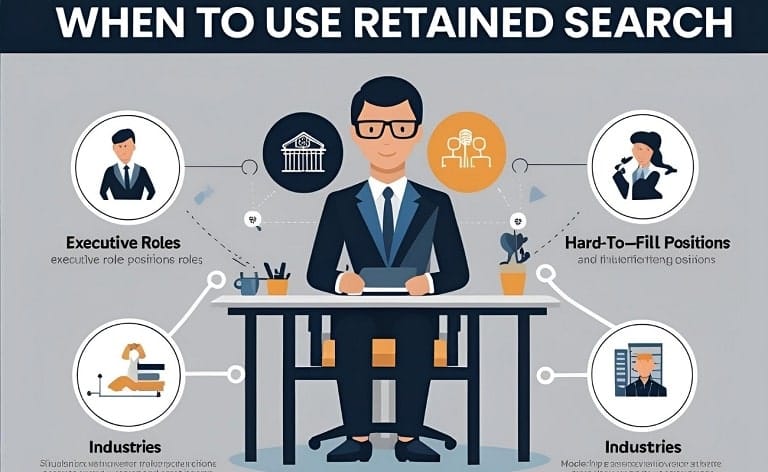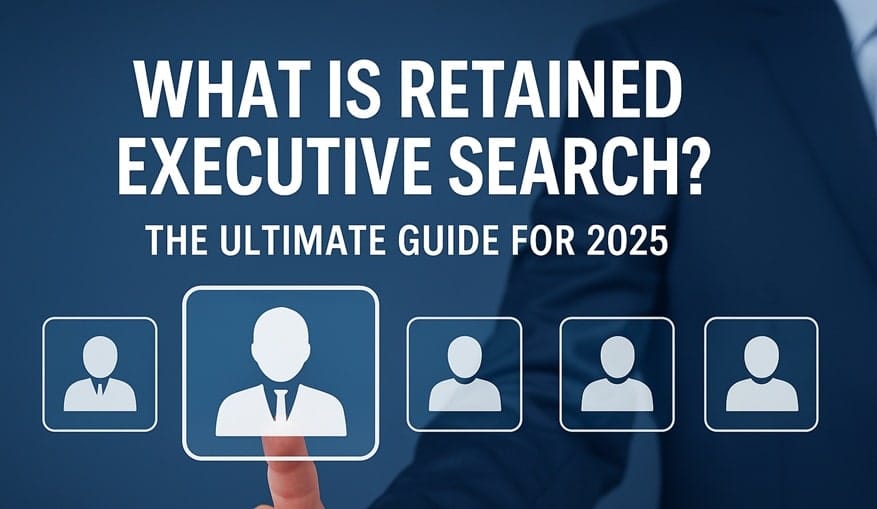- What Is Retained Search? (The Core Definition)
- Why Choose Retained Search? (The Core Benefits)
- When to Use Retained Search (Ideal Scenarios)
- Retained Search vs. Contingency: A Head-to-Head Comparison
- The Retained Search Process: A Step-by-Step Journey
- The Investment: Understanding Retained Search Costs & ROI
- How to Choose the Right Retained Search Firm
- The Future: Retained Search Trends in 2025
- Frequently Asked Questions (FAQ)
- Is Retained Search Right for Your Business? (Conclusion & Next Steps)
You finally got board approval to replace a key executive—or you’re scaling fast and need a proven leader to drive transformation. But after weeks of searching, all you’re seeing are recycled resumes, unqualified applicants, or candidates who ghost after the first round.
Sound familiar?
This is the executive hiring trap that too many companies fall into—especially when they treat C-level recruiting like filling a mid-level vacancy. In today’s competitive, passive-talent-driven market, the best leaders aren’t applying to your job posts… and they’re definitely not waiting in a database.
That’s where retained executive search comes in.
Whether you’re a CEO seeking transformational leadership, a CHRO overseeing succession planning, or a private equity partner aiming to upgrade a portfolio team, this guide is for you.
In this comprehensive 2025 playbook, you’ll learn:
- What retained search really means—and how it differs from contingent recruiting
- The full retained search process, step by step
- When it makes sense to use a retained firm (and when it doesn’t)
- How much it costs and how to calculate the ROI
- What to look for in a top-tier retained search partner
- And the key trends shaping retained executive search in 2025
If you’re making a mission-critical executive hire, this guide will help you do it right.
What Is Retained Search? (The Core Definition)

Retained search is a premium executive recruiting model used to fill senior leadership and mission-critical roles. In a retained search, a company engages a search firm exclusively and pays an upfront or milestone-based fee to conduct a thorough, research-driven, and consultative recruitment process.
Unlike transactional or contingency models, retained search is not about tossing resumes into your inbox. It’s about building a true hiring partnership—with a laser focus on quality, fit, and long-term impact.
The 3 Pillars of a True Retained Search: Exclusivity, Partnership, and Commitment
- Exclusivity
You retain the firm to work on the search—and only them. This ensures full confidentiality and strategic alignment. You won’t have multiple recruiters tripping over each other or presenting the same candidates. - Partnership
A retained firm acts as an extension of your leadership team. They help define the role, shape the employer value proposition, and often advise on compensation, succession, and team structure. - Commitment
Because they’re paid to do the job well—not just fast—retained search firms invest heavily in research, outreach, and vetting. You’re guaranteed a slate of rigorously assessed, high-caliber candidates.
Think of it this way: If contingency search is speed dating, retained search is executive matchmaking.
Who It’s For: C-Suite, Senior Leadership, and Critical Hires
Retained search is typically used when the stakes are high and failure is expensive. Common scenarios include:
- CEO, CFO, COO, and other C-level placements
- Executive succession planning or leadership transitions
- Hiring in confidential or politically sensitive situations
- Finding rare or highly specialized talent
- Transformational roles in private equity portfolio companies
If you can’t afford to get it wrong, you can’t afford not to go retained.
Common Myths About Retained Search, Debunked
- “It’s only for Fortune 500 companies.”
False. Mid-sized companies and startups also use retained firms for pivotal leadership hires. - “Retained firms are slower.”
Not true—most quality firms move just as fast, but with far more rigor and precision. - “It’s too expensive.”
The cost of a bad hire (or six months of lost momentum) is often far higher than the fee. - “They just repackage LinkedIn candidates.”
Top retained firms rely on proprietary networks, original research, and direct outreach to passive talent—not job boards.
Why Choose Retained Search? (The Core Benefits)

When you’re hiring for a leadership role that directly impacts revenue, culture, or strategic direction, you can’t afford to gamble. Retained executive search offers a level of precision, commitment, and strategic value that transactional recruiting models simply cannot match.
Here’s why retained search is the preferred approach for high-stakes executive hires in 2025:
Unparalleled Access to Passive, High-Caliber Talent
The best candidates aren’t browsing job boards. They’re thriving in their current roles—unreachable through traditional sourcing methods.
Retained firms specialize in proactively identifying and engaging these passive, high-impact leaders. Using deep industry mapping, confidential outreach, and trusted networks, they surface talent your internal team or contingency recruiters can’t reach.
Result: You’re not settling for who’s available—you’re choosing from the best in the market.
A True Strategic Partnership and Market Advisory
Retained search isn’t just about filling a role—it’s about solving a business problem.
A retained firm acts as a thought partner, not just a vendor. They help:
- Shape the position based on current market trends
- Advise on compensation, succession planning, or team design
- Align the hiring process with long-term business goals
You get real-time market feedback, competitive intelligence, and executive-level insight every step of the way.
Guaranteed Commitment and a Higher Success Rate
Because retained firms are paid upfront or in structured milestones, they’re fully committed to completing the search successfully. There’s no incentive to cut corners or flood you with marginal candidates just to close a fee.
You’ll typically receive:
- A curated shortlist of fully vetted, culture-aligned leaders
- Regular progress updates and structured reporting
- Post-placement follow-up and onboarding support
Translation: Fewer false starts, better long-term fit, and significantly less executive churn.
Confidentiality, Discretion, and Employer Brand Protection
Need to replace a sitting executive? Launching a new division? Planning an M&A deal? Retained search ensures total confidentiality and control over how your brand is presented in the market.
From anonymous outreach to careful narrative framing, these firms are experts at maintaining discretion—while positioning your company as a top-tier opportunity for high-level talent.
Bottom line: Retained search is an investment, but for mission-critical roles, it’s the only approach that delivers the depth, diligence, and executive-level outcome your business requires.
When to Use Retained Search (Ideal Scenarios)

Now that you understand the strategic value of retained search, the next question is: When is it truly the right tool for the job?
While not every hire demands this level of rigor, there are critical scenarios where retained search is not just recommended—it’s essential.
For C-Level and Executive Leadership Roles
When hiring for positions that directly impact your organization’s direction—CEO, CFO, COO, CHRO, CTO, or Board Member—the stakes couldn’t be higher. A poor leadership hire can cost millions in lost revenue, damaged culture, or failed execution.
Retained search ensures:
- A confidential, high-touch process
- Candidates aligned with vision, values, and performance goals
- Advisory support for boards and senior leadership teams
Use it when: You need more than a resume—you need a proven, trusted leader.
For Highly Confidential or Sensitive Hires
Some searches must be kept completely under wraps:
- Replacing an underperforming executive
- Mergers or acquisitions in progress
- Organizational restructures
Retained search firms are experts at discretion. They know how to conduct stealth outreach, maintain brand protection, and carefully manage communications with potential candidates.
Use it when: The role is politically sensitive or tied to a strategic shift you can’t yet make public.
For Niche, Hard-to-Fill, or Technical Positions
Certain roles require rare skill sets, certifications, or industry knowledge:
- Heads of AI/ML or Biotech R&D
- Regulatory experts in global pharma
- CTOs in emerging tech fields
In these cases, passive candidates with the right pedigree are few and far between—and they’re not applying to online listings.
Retained search allows for:
- Deep market mapping and original research
- Global candidate sourcing
- Customized screening and technical vetting
Use it when: You’re looking for a unicorn—and time and accuracy matter.
When Building a New Team or Undergoing a Turnaround
Whether you’re:
- Building a leadership team post-funding
- Revitalizing a stalled business unit
- Managing a portfolio company transformation
…you need a coordinated, culture-aligned hiring approach. Retained firms often place multiple interdependent leaders who must align in vision, communication, and execution style.
They also help design onboarding and integration strategies to reduce friction and accelerate results.
Use it when: You need not just individual hires—but cohesive leadership that drives change.
In short:
Retained search is your go-to model when the role is:
- High-impact
- Hard to fill
- Highly confidential
- Or part of a broader organizational shift
If you can’t afford to fail, you can’t afford not to go retained.
Retained Search vs. Contingency: A Head-to-Head Comparison

Choosing between retained and contingent search can feel like comparing apples to oranges—both are recruiting models, but they serve very different purposes. If you’re hiring a sales rep, contingency might work. But if you’re hiring a COO, the model you choose can make or break the outcome.
Here’s how they stack up across the dimensions that matter most:
🔍 Quick Comparison Table
| Aspect | Retained Search | Contingency Search |
|---|---|---|
| Engagement Model | Exclusive, strategic partnership | Non-exclusive, transactional |
| Fee Structure | Upfront or milestone-based payments | Fee paid only upon successful placement |
| Focus | Quality, cultural fit, and long-term impact | Speed and volume over deep vetting |
| Candidate Pool | Primarily passive, high-impact, confidentially sourced | Mostly active candidates already in recruiter networks |
| Search Process | Structured, consultative, and research-driven | Reactive, based on existing database |
| Commitment Level | High—firm is accountable for successful outcome | Lower—risk of competing priorities across clients |
| Best For | C-suite, confidential, complex or strategic hires | Mid-level, junior, or high-volume roles |
The Model: Partnership vs. Transaction
Retained search is built on trust and exclusivity. You engage one firm to conduct a thorough, strategic search on your behalf—like hiring a consultant to solve a business-critical problem.
Contingent search, by contrast, is volume-driven. Multiple recruiters may race to send candidates, with little investment in research, alignment, or long-term fit. It’s a transactional model designed for speed, not precision.
Bottom line: Retained = consultative partner.
Contingency = resume vendor.
The Cost: Upfront Investment vs. Placement Fee
With retained search, you typically pay a portion of the fee upfront or in scheduled milestones. This investment ensures full commitment, dedicated resources, and process accountability.
Contingency firms work on spec—they get paid only if a hire is made. While that may sound appealing, it often leads to conflicts of interest, rushed vetting, and less skin in the game.
Retained fees = a commitment to excellence.
Contingency fees = a bet that speed will beat quality.
The Process: Deep Diligence vs. Speed
Retained search firms follow a methodical process:
- Role scoping
- Market mapping
- Passive outreach
- Behavioral interviewing
- Confidential referencing
Contingent firms move fast and often rely on resumes already in their system or from active job seekers.
If you’re solving a complex leadership puzzle, retained gives you the strategy.
If you need to fill a spot fast, contingency might be sufficient.
Candidate Pool: Exclusive & Passive vs. Active & Widely Available
Retained firms specialize in sourcing passive, high-performing executives who aren’t actively looking—but may be open to the right opportunity. These candidates are typically not accessible through traditional channels.
Contingent firms usually pull from active candidates or those already in their database, which means more limited reach and more competition from other employers.
Retained = access to the hidden 80% of the market
Contingency = visibility into the 20% who are actively searching
Key Takeaway:
If the role is mission-critical, confidential, or strategic, retained search provides the structure, reach, and rigor needed to find the right leader—not just a resume that checks the boxes.
The Retained Search Process: A Step-by-Step Journey

Retained executive search isn’t a black box. It’s a structured, high-touch journey designed to deliver not just a hire—but the right hire.
Here’s what a typical retained search process looks like from the inside, step by step:
Step 1: Discovery & Strategy (The Intake Meeting)
Every great search starts with clarity. In this initial phase, the retained firm meets with key stakeholders—often including the CEO, CHRO, or board—to deeply understand:
- The business context and leadership challenge
- Success metrics for the role
- Ideal candidate traits and non-negotiables
- Culture, team dynamics, and reporting structure
The outcome is a customized positioning brief that guides the entire search.
🎯 This isn’t just about writing a job description—it’s about defining success.
Step 2: Market Mapping & Candidate Identification
Next comes the research phase. The search team conducts original market mapping, identifying potential candidates across:
- Competitors
- Adjacent industries
- High-growth or best-in-class companies
- The firm’s proprietary network
Rather than relying on resumes in a database, this phase builds a fresh, tailored talent universe aligned with your goals.
📊 You’ll often receive insight into compensation benchmarks, talent availability, and role competitiveness.
Step 3: Outreach & Engagement
Once top targets are identified, the retained firm begins discreet, strategic outreach—often by senior recruiters or partners.
This is where retained firms shine:
- Crafting compelling narratives that attract passive leaders
- Qualifying interest while maintaining confidentiality
- Positioning your opportunity in a way that resonates with executive talent
📞 The best leaders aren’t applying. They’re being engaged—strategically and persuasively.
Step 4: Assessment & Vetting
Only a select group of candidates make it to this phase. Each is evaluated through:
- Deep behavioral interviews
- Leadership style and culture fit analysis
- Alignment with success metrics defined in Step 1
Some firms use psychometric testing or third-party leadership assessments to validate competencies.
🧠 You’re not just seeing who looks good on paper—you’re getting deep insight into how they think, lead, and deliver results.
Step 5: Shortlist Presentation & Interviews
You’ll receive a curated shortlist, usually 3–5 top-tier candidates, each with:
- A summary of strengths, weaknesses, and fit
- Compensation expectations and availability
- Executive summaries or scorecards
From there, the interview process begins—often coordinated and facilitated by the search firm.
🗂️ No wasted interviews. Only leaders worth your time.
Step 6: Offer, Negotiation & Closing
Once you’ve chosen a finalist, the firm acts as your strategic intermediary in the offer phase.
- Managing expectations
- Navigating complex compensation discussions
- Ensuring a clean and timely close
They can also handle delicate counteroffer situations or timing issues with grace and discretion.
🤝 The right offer, framed the right way, avoids second thoughts and ensures alignment.
Step 7: Onboarding Support & Guarantee
Even after the contract is signed, the partnership doesn’t end.
Many retained firms:
- Assist in onboarding and integration planning
- Check in regularly with client and candidate
- Offer a replacement guarantee if the hire doesn’t work out within a specified window
🚀 Because success isn’t just about hiring. It’s about staying—and thriving.
This seven-step journey is what makes retained search so powerful. It’s not just recruitment.
It’s executive-level talent strategy—built to deliver lasting results.
The Investment: Understanding Retained Search Costs & ROI

Choosing a retained search firm is an investment in leadership. But what exactly does it cost—and what do you get in return?
Let’s break it down.
Common Fee Structures Explained (Percentage, Flat Fee)
Most retained executive search firms operate on one of two pricing models:
📌 Percentage-Based Model (Most Common)
- Typically 25–33% of the candidate’s first-year total compensation
- The fee is usually split into three installments:
- Retainer at launch
- Upon shortlist presentation
- Upon successful placement
📌 Flat Fee Model
- A fixed price agreed upon at the start
- Often based on the role’s complexity, seniority, and time investment
- Less common, but favored by some clients for budget certainty
💡 Retained search fees reflect not just recruitment, but rigorous vetting, passive talent outreach, and long-term fit.
What’s Included in the Fee?
A retained search fee is more than a payment for a hire—it’s for an end-to-end, strategic hiring process.
Most reputable firms include:
- In-depth intake and role scoping
- Market research and talent mapping
- Passive candidate outreach and engagement
- Executive-level screening and interviews
- Shortlist curation and presentation
- Offer negotiation and closing
- Onboarding support and integration follow-up
- Replacement guarantee (often 6–12 months)
🔍 Think of it as paying for precision, protection, and peace of mind—not just resumes.
The Real ROI: Calculating the Cost of a Bad Hire
Hiring the wrong executive is expensive. Consider the potential impact:
- Wasted salary and bonuses
- Lost productivity and team morale
- Client attrition or missed growth targets
- Restarting the hiring process (and time lost)
According to various studies, a failed senior-level hire can cost 4 to 15 times the executive’s annual salary—especially in roles tied to revenue, operations, or strategy.
💰 When you factor in risk mitigation, speed to hire, and long-term fit, a retained search often pays for itself many times over.
Bottom line?
Retained search is not a cost—it’s an investment in leadership excellence, built to yield long-term value and measurable business results.
How to Choose the Right Retained Search Firm

Not all retained search firms are created equal. The right partner can transform your executive team. The wrong one can waste time, money, and momentum.
Here’s how to choose wisely.
Key Questions to Ask Before You Commit
Before signing any agreement, dig deeper with questions like:
- What is your success rate for retained searches at this level?
- How do you source passive candidates?
- Can you walk us through your search process, step-by-step?
- What’s your typical timeline to shortlist?
- Who will actually lead the search—and what’s their experience?
- What’s your guarantee policy?
- How do you ensure cultural and leadership fit—not just resume fit?
🎯 A reputable firm won’t just answer these—they’ll welcome them.
Evaluating Industry Specialization and Track Record
Retained search is not one-size-fits-all.
Look for:
- Domain Expertise: Do they understand your industry’s challenges and talent landscape?
- Role Familiarity: Have they placed executives in similar functions and company stages (e.g., growth, turnaround, IPO)?
- Client References: Can they provide real-world testimonials or case studies?
- Repeat Clients: A high rate of recurring business often signals trust and consistent performance.
🏆 Industry specialists often have deeper networks, faster results, and stronger cultural alignment insights.
Red Flags to Watch For in a Potential Partner
Hiring a retained search firm is a high-stakes decision. Avoid firms that:
- Are vague about their process or candidate sourcing strategy
- Don’t offer a dedicated point of contact or lead consultant
- Have little to no executive-level references
- Promise unrealistic timelines or “guaranteed” hires
- Push for upfront payment without clearly defined milestones
- Seem overly reliant on LinkedIn or job boards
🚨 Transparency, rigor, and client fit are non-negotiables. If something feels off—it probably is.
Final Thought:
The best retained search partners aren’t just vendors. They’re strategic allies in shaping the future of your leadership.
The Future: Retained Search Trends in 2025

Retained executive search is evolving—driven by new technologies, shifting workforce expectations, and global leadership demands. If you’re planning a critical hire this year or beyond, here’s what to watch.
The Impact of AI and Technology on Sourcing
AI is transforming how retained firms identify, assess, and engage candidates. But unlike high-volume recruiting, where automation dominates, retained search uses tech to augment—not replace—human judgment.
Key advancements include:
- Predictive analytics to benchmark top performers
- AI-assisted talent mapping and market intelligence
- Automated outreach personalization at scale
- Video-based behavioral analysis to assess fit beyond resumes
⚙️ The human element—relationship-building, cultural intuition, executive presence—remains irreplaceable.
The Increasing Focus on Diversity, Equity & Inclusion (DEI)
DEI is no longer optional—it’s a board-level priority.
Leading retained firms now:
- Build diverse candidate slates by design, not by chance
- Advise clients on inclusive leadership profiles and bias reduction
- Monitor DEI outcomes over time—not just at placement
Clients expect more than a diverse shortlist—they want a diverse-ready search process.
🌍 In 2025, the ability to deliver inclusive leadership is a differentiator, not a checkbox.
The Rise of Remote and Global Executive Hires
The post-pandemic world normalized remote work—but executive hiring is going global.
Organizations now tap leadership from:
- Different time zones and continents
- Borderless talent pools with digital leadership experience
- Hybrid-ready executives who can lead distributed teams effectively
This trend expands access—but also increases complexity.
Retained firms must now navigate:
- Global compensation models
- Cross-cultural leadership dynamics
- International onboarding and compliance
🌐 The best leaders may no longer be across town—they may be across the globe.
In short:
Retained search in 2025 is smarter, more inclusive, and more global than ever.
Firms that adapt will lead. So will the companies that partner with them.
Frequently Asked Questions (FAQ)

Retained search can be a complex topic—so we’ve answered the most common questions executives and HR leaders ask before engaging a firm.
Q1: How long does a retained search take?
Most retained searches take 6 to 12 weeks from kickoff to signed offer.
The timeline depends on:
- The seniority and specialization of the role
- Geography and market dynamics
- Client responsiveness during interviews and decision stages
Top-tier firms follow a structured process that prioritizes quality over speed, while keeping momentum high.
Q2: Is the retained fee refundable?
Typically, no—retained fees are non-refundable because they cover upfront work:
- Market research
- Strategy and alignment meetings
- Candidate sourcing and assessment
However, many firms offer guarantees (e.g., free replacement within 6–12 months) if the hire doesn’t work out.
🛡️ Always ask about guarantees, not just refund terms.
Q3: What involvement is needed from our team?
Retained search is collaborative. Your role includes:
- Participating in the initial intake and alignment phase
- Providing feedback on candidate profiles and interviews
- Acting quickly on finalist interviews and offers
The best outcomes happen when the search firm becomes an extension of your team—not an outside vendor.
Q4: What is an “off-limits” policy?
An off-limits policy prevents the search firm from recruiting talent from your company after working with you.
It protects clients and ensures trust in long-term partnerships.
However, this also means that the firm may not be able to source from certain companies they’ve recently served.
🤝 Ask upfront: “Which companies are off-limits for you?” to avoid surprises.
Still have questions?
Consider booking a discovery call with a retained search partner to explore fit, expectations, and strategy.
Is Retained Search Right for Your Business? (Conclusion & Next Steps)

Retained search isn’t for every hiring scenario—but for critical executive roles, it can be a game-changer. Here’s what we’ve learned:
- It offers depth, rigor, and confidentiality you won’t get from contingent models.
- You’re paying not just for resumes—but for research, access, and risk mitigation.
- It works best when you need leadership that transforms, not just maintains.
- The right firm will act as a strategic advisor, not just a recruiter.
If you’re hiring for a senior leadership role where failure isn’t an option, retained search may be your best investment.
Ready to Take the Next Step?
🎯 Schedule a Complimentary Consultation
Let’s talk about your hiring goals—and whether retained search is the right approach for your organization.
Book a Call
📥 Download Our Retained Search Readiness Checklist
Make sure your team is aligned and prepared before engaging a search firm.
Download Now
Need help evaluating your options?
Our team at JRG Partners has placed transformational leaders across industries for over a decade.
We’re happy to share insights—even if you’re not ready to launch a search today.


